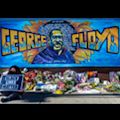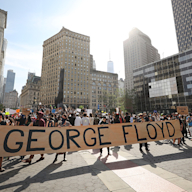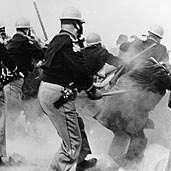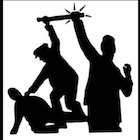Search results
George Perry Floyd Jr. (October 14, 1973 – May 25, 2020) was a black American man who was murdered by a white police officer in Minneapolis, Minnesota, during an arrest made after a store clerk suspected Floyd may have used a counterfeit twenty-dollar bill, on May 25, 2020.
- 5
- Circumstances of his death
- Big Floyd
- Overview
- Impoverished childhood
- Music records, criminal record
- Family history, personal life
- Life in Minneapolis
- Memorial Day
- Floyd’s legacy
George Floyd (born October 14, 1973, Fayetteville, North Carolina, U.S.—killed May 25, 2020, Minneapolis, Minnesota) Black man whose videotaped death under the knee of a white police officer sparked protests in 2020, including some of the largest street demonstrations in U.S. history. Before his murder made him a global icon for racial justice, Flo...
Known to family and friends as “Perry,” Floyd was three years old when he moved to Texas from North Carolina with his mother and siblings. The family settled in Houston’s historically Black Third Ward, moving into a housing project that was segregated by government design and dilapidated due to government neglect. Coming of age in one of the most impoverished sections of the city, Floyd quickly came to know the cruel reality of growing up Black and poor. He often had to eat banana-and-mayonnaise sandwiches and wash his clothes in the bathroom sink. He lost friends to gun violence and became accustomed to seeing police cars speeding through his neighbourhood.
Still, Floyd, who grew fond of telling friends, relatives, and strangers “I love you,” showed a desire to transcend his circumstances from an early age. In a brief essay he wrote while in second grade, in February 1982, Floyd indicated that he wanted to sit on the highest court in the land:
When I grow up, I want to be a Supreme Court Judge. When people say ‘Your honor, he did rob the bank,’ I will say ‘Be seated.’ And if he doesn’t, I will tell the guard to take him out. Then I will beat my hammer on the desk. Then everybody will be quiet.
However, an underfunded, segregated school system and the trauma of poverty made realizing his dreams particularly elusive. As Floyd sprouted to more than 6 feet (1.83 metres) tall as an adolescent, he was encouraged to pursue athletics as the best way to earn a living and escape his circumstances. As he began to condition his body for athletic excellence, his mind remained focused on making a global impact.
“I’m going to be big,” he told his high-school classmates in the spring of 1992. “I’m going to touch the world.”
Students save 67%! Learn more about our special academic rate today.
Floyd soon pursued another avenue for touching the world: music. He befriended Robert Earl Davis, Jr., an up-and-coming DJ in Houston popularly known as DJ Screw, and began to appear as a rapper on Davis’s well-received mixtapes. Performing as “Big Floyd” on another friend’s song, Floyd opted against rapping about money and cars and instead bared his insecurities as a man still struggling to find his footing in his 20s.
He rapped in one song:
I’ve been broke for so long.
I’ve been stuck in last place for so long.
Loaded with potential, but I’m still going wrong…
It was about this time that Floyd began to get in trouble with the law. In the late 1990s and early 2000s, Floyd was arrested and imprisoned multiple times, mostly for nonviolent drug offenses. Unable to afford a lawyer, he pleaded guilty each time and served several monthslong stints in jail. His legal troubles increased as politicians and police across the country pushed the War on Drugs, which disproportionately targeted young Black men like Floyd, often with devastating consequences. Upon becoming a felon—after an $18 drug deal landed him in jail for six months, a time during which Floyd said he developed claustrophobia—Floyd quickly found his options for legitimate work largely disappear. He soon fell from dealing drugs to using them and told officers during a 2002 arrest that he suffered from a substance abuse problem and depression. He received no treatment but was sent to jail for eight months.
Floyd’s maternal great-great-grandfather, Hillery Thomas Stewart, was born enslaved in 1857. After receiving his freedom, he amassed more than 500 acres (200 hectares) of farmland in Harnett county, North Carolina. As one of the wealthiest Black men in his community, he dreamed of passing down generational wealth to his descendants. But white officials in town had other plans—launching a series of fraudulent and predatory tax and business schemes to strip him of his land in the late 19th and early 20th centuries. Floyd’s forebearers were left to work as sharecroppers for decades, toiling on white-owned tobacco farms and never rising above the poverty line.
Floyd’s mother, Larcenia, left North Carolina’s tobacco fields in the mid-1960s for New York, where she met George Perry Floyd, Sr., a musician. The two married in 1969. Born four years later after the couple had relocated to Fayetteville, North Carolina, George Perry Floyd, Jr., was a middle child with two elder sisters and two younger brothers.
He played the role of a household father figure after his parents separated and often tried to impart life lessons to his siblings. “One roof, one family,” he often said, repeating a mantra of his close-knit neighbourhood.
Floyd never married, but in 2013 his girlfriend gave birth to a daughter named Gianna. After becoming a father and reconnecting with his Christian faith, Floyd recommitted to getting his life together and decided to make a change at the age of 43.
In 2017 Floyd took a Greyhound bus from Houston to Minneapolis, determined to get a fresh start and break free from addiction in a state with a more robust social safety net. On the advice of his pastor, he enrolled in Our Turning Point, a substance abuse rehabilitation program specifically tailored for healing Black men.
It did not take long for things to start improving for Floyd in Minneapolis. He graduated from the rehabilitation program, moved into a townhouse in a tony suburb, and got two jobs working at the local Salvation Army and as a bouncer at a Minneapolis nightclub. He started training to be a truck driver and was beginning to earn enough money to send some home to his family in Houston.
On May 25, 2020, Floyd was with two friends at the CUP Foods store in Minneapolis when a cashier accused him of paying for cigarettes with a counterfeit twenty-dollar bill. The police were called, and Floyd was handcuffed and restrained. While Floyd was on the ground, one of the officers who responded, Derek Chauvin, pressed his knee into his neck for more than nine minutes—maintaining the pressure even as Floyd became motionless on his stomach. Bystanders recorded the scene on their cell phones and yelled for Chauvin and the other officers to show mercy to Floyd, who was crying out, “Mama!” and saying he could not breathe.
One bystander, 17-year-old Darnella Frazier, filmed the interaction, including some of the 9 minutes and 29 seconds Chauvin spent kneeling on Floyd’s neck and back. Floyd said “I can’t breathe” at least 27 times during the ordeal but was ignored each time. Hours later—after paramedics had arrived on the scene and taken Floyd to the hospital, where he was pronounced dead—Frazier uploaded the video to Facebook. It quickly went viral.
Floyd’s murder set off mass protests that began in Minneapolis and spread throughout the United States and ultimately around the world, with Black Lives Matter demonstrators and other activists occasionally clashing with police officers as they called for an end to police brutality and racial injustice. During the fiery summer of activism that followed Floyd’s death, his name was uttered by presidents, prime ministers, and the pope. His picture appeared on murals and in museums around the world. Lawmakers, police departments, and corporations cited his death as a catalyst for their decisions to enact sweeping changes aimed at improving diversity and combating inequity. U.S. Pres. Joe Biden invoked Floyd’s name during his first joint address to Congress in 2021, pledging to sign the George Floyd Justice in Policing Act, legislation that would ban police choke holds and implement several other measures. Congress never passed the bill, though an executive order signed by Biden and measures enacted at the state and local level aimed to deter officers from abusing citizens.
Derek Chauvin, the officer who pressed his knee on Floyd’s neck, was convicted of second-degree murder after a heavily watched trial. It was the first time a white police officer in Minnesota had been convicted of murdering a Black person. He was sentenced to 22 and a half years in prison, and also pleaded guilty to federal charges. Three other officers involved in Floyd’s death were also convicted of a range of charges. The city of Minneapolis settled a lawsuit with Floyd’s family for $27 million, among the largest wrongful death settlements involving a police killing in U.S. history.
- Toluse Olorunnipa
Jul 29, 2022 · By The New York Times. July 29, 2022. The death of George Floyd, a 46-year-old Black man, in May 2020 drew widespread outrage after a video circulated online showing Officer Derek Chauvin...
- 10 min
Apr 20, 2021 · George Floyd, From ‘I Want to Touch the World’ to ‘I Can’t Breathe’. Mr. Floyd had big plans for life nearly 30 years ago. His death in police custody is powering a movement against ...
On May 25, 2020, George Floyd, a 46-year-old black American man, was murdered in Minneapolis by Derek Chauvin, a 44-year-old white police officer. Floyd had been arrested after a store clerk alleged that he made a purchase using a counterfeit $20 bill.
May 24, 2021 · 24 May 2021. George Floyd death. Getty Images. A year has passed since George Floyd - an unarmed African American man - was murdered during an arrest by white officer Derek Chauvin.
Apr 20, 2021 · George Floyd: The murder that drove America to the brink. 20 April 2021. By Tara McKelvey,BBC News, Minneapolis. BBC. Breez Sapphira, 28, at a shoe boutique where she worked, followed the trial...









